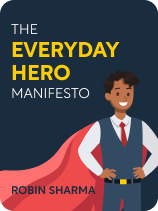

This article is an excerpt from the Shortform book guide to "The Everyday Hero Manifesto" by Robin Sharma. Shortform has the world's best summaries and analyses of books you should be reading.
Like this article? Sign up for a free trial here.
How do bad experiences weigh on your heart? How can you recover from trauma that’s affecting your future?
Your heart can only take so much damage. The trauma that you experienced in the past will only hurt it more if you don’t confront it head-on.
Here’s how to recover from trauma, according to The Everyday Hero Manifesto by Robin Sharma.
Empower Your Heart
Sharma says that past traumas often weigh heavily on your heart and stop you from bringing your full energy and enthusiasm to what you’re doing. We’ll explore two steps Sharma shares on how to recover from trauma, thereby empowering your heart.
(Shortform note: If you suffer from post-traumatic stress disorder (PTSD), the psychological effects of past events can quite literally take you out of the present moment—for instance, if you experience flashbacks or intrusive thoughts. These effects can stop you from putting your attention and energy into the task at hand, as well as being generally distressing. Even if you don’t suffer from PTSD, your past experiences affect your present actions in ways that we’ll explore throughout the rest of this section.)
Step 1: Admit Your Heart Is Damaged
The first step to healing your heart is to admit it’s damaged: Even if you haven’t endured severe trauma, you’re still carrying old hurts, disappointments, and embarrassments, and those past events could still be affecting you. For example, if you have a painful memory of your ideas being ignored or laughed at, you may be more reluctant to share your ideas today.
(Shortform note: The reason upsetting and traumatic experiences can affect you so strongly is that they change your brain physically. Most notably, they change the areas of the brain associated with regulating emotions and coping with fear. This means that, after you experience an upsetting or traumatic event, you could develop an irrational fear of any situation that reminds you of it. For example, if you once got stuck in a closet as a child, you might have an intense fear of small spaces not just because you’re remembering something upsetting, but because your brain is telling you that you’re in immediate danger, even if you know rationally that you’re not.)
Step 2: Practice Mindfulness
Next, Sharma suggests healing your heart by practicing mindfulness: When you experience powerful emotions (positive or negative), focus on the physical sensations you’re feeling instead of your thoughts. Don’t try to judge what you’re feeling, just identify and acknowledge it. For example, are your shoulders tense? Is your jaw clenched? Do you feel sick to your stomach?
(Shortform note: It might seem strange to focus on physical sensations when you’re trying to get to grips with your emotions, but there’s a connection between your mind and your body that makes this mindfulness practice effective. Every emotion causes certain physical responses, so by identifying those physical sensations, you can work backward to understand which emotions caused them. Notably, the mind-body connection works both ways, meaning that you can also change your emotions (to an extent) through physical actions; for instance, you may be able to genuinely improve your mood by faking a smile.)
Once you’ve identified what you’re feeling, allow yourself to experience it fully. It’s often uncomfortable; you’ll be tempted to try to ignore the sensations or force them to stop. However, trying to get rid of those sensations is counterproductive: It’ll only keep you focused on them (much like how saying “Don’t think of an elephant!” will cause you to immediately think of an elephant). That’s why accepting your feelings is a crucial part of moving past them.
Finally, once you’re able to, let go of those feelings and allow them to fade away.
| Tip: Practice Radical Acceptance Sharma says that, after fully experiencing your feelings, you can let them go. In Radical Acceptance, Tara Brach goes into greater detail about a practice that can help you to move past unpleasant feelings. This process—radical acceptance—has two elements: 1. Recognition. This is the first step that Sharma describes above: clearly identifying your feelings as they happen. This is the first step toward radical acceptance because you first have to understand what you’re accepting. 2. Compassion. Be kind to yourself and to your feelings. Don’t berate yourself for having feelings you don’t like or that you think you “shouldn’t” be having. Instead, feel them fully (as Sharma suggests), and remember that you always deserve love and kindness—you simply happen to be experiencing something unpleasant right now. That doesn’t mean you should act on those unpleasant feelings—for instance, lash out because you’re angry. Rather, you can accept those feelings and move past them without indulging them or blaming yourself for them. Brach says that meeting strong feelings with recognition and compassion will allow you to accept those feelings for what they are: temporary experiences that will rise up and fade away naturally. She believes that a powerful benefit of this mindfulness practice is the ability to understand and love yourself, even when you’re having thoughts and feelings you don’t want to have. You’ll come to accept that experiencing these temporary sensations doesn’t change your essential goodness. You’ll also find, over time, that you’re able to control your responses. In other words, you’ll still have strong thoughts and feelings, but you won’t feel compelled to act on them or try to counterproductively force them away. |

———End of Preview———
Like what you just read? Read the rest of the world's best book summary and analysis of Robin Sharma's "The Everyday Hero Manifesto" at Shortform.
Here's what you'll find in our full The Everyday Hero Manifesto summary:
- Why you don't need superpowers in order to achieve great things
- How to unlock your heroic potential and become a force for good
- Why helping others is the best way to enrich your own life






